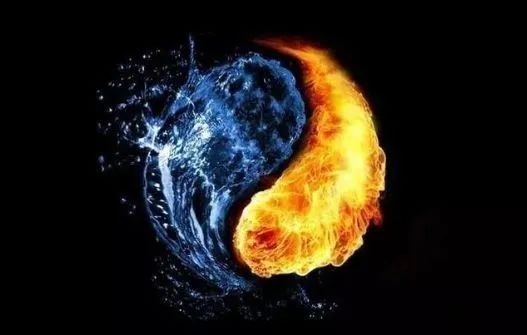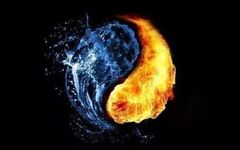Cold and heat, from a conventional perspective, are two contradictory aspects that seem unable to coexist. However, this is not the case in practice.In Traditional Chinese Medicine (TCM), the simultaneous occurrence of cold and heat symptoms is not uncommon, and this phenomenon is referred to as hanre cuoza (cold-heat complex). There are also alternating occurrences of cold and heat.Today, we will discuss the easily distinguishable cold-heat complex. Upper and Lower Cold-Heat ComplexWhen the upper and lower parts of the body exhibit different cold and heat properties, it is termed shangxia hanre cuoza (upper and lower cold-heat complex). This includes two conditions: upper cold and lower heat, and upper heat and lower cold. The terms upper and lower are relative concepts. For instance, if we take the diaphragm as a boundary, the chest is considered upper, while the abdomen is lower. Within the abdomen, the upper abdomen (stomach area) is also considered upper, while the lower abdomen (bladder, large and small intestines) is considered lower.1. Upper Cold and Lower HeatIn this condition, the upper part of the body exhibits cold symptoms while the lower part shows heat symptoms. For example, a patient may experience cold pain in the stomach area, vomiting clear fluids, while also having frequent urination, painful urination, and short, red urine. This indicates cold in the stomach and heat in the bladder. This is characterized by cold in the middle jiao (middle burner) and heat in the lower jiao (lower burner), with the middle jiao being above the lower jiao.This condition can arise from exposure to cold pathogens or from the body’s own yang deficiency and excess yin. Insufficient yang energy or damage from external cold prevents it from warming the body, leading to cold limbs, curled posture, and a pale complexion. Excessive internal cold leads to a lack of thirst. Yang deficiency fails to transform fluids, resulting in clear and cold discharges such as phlegm, saliva, and urine. Cold pathogens can damage the spleen, or prolonged spleen yang deficiency can lead to poor digestion, resulting in loose stools. Yang deficiency fails to transform, leading to internal cold and dampness, which presents as a pale tongue with a white, slippery coating. Weak yang energy results in insufficient force to circulate the blood, hence a slow pulse; cold constricts, causing the pulse to be tight.2. Upper Heat and Lower ColdIn this condition, the upper part of the body exhibits heat symptoms while the lower part shows cold symptoms. For example, a patient may feel heat in the chest and cold in the intestines, presenting with symptoms of heat in the chest (irritability, sore throat, dry mouth) and cold in the abdomen (abdominal pain relieved by warmth, loose stools). This is classified as upper heat and lower cold.This condition is commonly seen in both acute and chronic presentations, often with heat in the upper jiao and cold in the middle jiao, leading to mutual obstruction of cold and heat, and dysfunction of yin and yang. Although the disease primarily affects the spleen and stomach, it can also involve multiple organs such as the kidneys and intestines, complicating and worsening the condition.Exterior and Interior Cold-Heat ComplexWhen both the exterior and interior of the body are affected by different cold and heat properties, it is termed biaoli hanre cuoza (exterior and interior cold-heat complex). This includes two conditions: exterior cold and interior heat, and exterior heat and interior cold.1. Exterior Cold and Interior HeatIn this condition, the exterior is cold while the interior is hot. This is often seen in cases where there is pre-existing internal heat, combined with an external invasion of wind-cold, or when an external pathogen transforms into heat while the exterior cold has not resolved. Symptoms may include chills and fever, no sweating, headache, body aches, shortness of breath, irritability, thirst, and a floating, tight pulse, indicating cold on the exterior and heat on the interior.This condition often arises from an external invasion of wind-cold, hence the absence of sweating, with joint pain, nasal congestion, and a heavy body. Internally, there is accumulated heat, leading to irritability, thirst, and sore throat; if the heat obstructs the lungs, it may cause cough and shortness of breath with yellow, thick phlegm; if heat accumulates in the lower jiao, it may lead to yellow urine and constipation. A yellow tongue coating and rapid pulse indicate internal heat.2. Exterior Heat and Interior ColdIn this condition, both the exterior and interior are affected, with heat on the exterior and cold on the interior. This is often seen in cases of pre-existing internal cold combined with an invasion of wind-heat, or when exterior heat symptoms have not resolved, leading to damage of the spleen and stomach yang. For instance, a patient may have a history of spleen and stomach deficiency with cold, and then contract wind-heat, presenting with fever, headache, cough, and sore throat (exterior heat symptoms), while also experiencing loose stools, clear, frequent urination, cold limbs, and lack of thirst (interior cold symptoms).This condition often arises from a pre-existing deficiency of spleen and stomach yang, combined with an invasion of wind-heat, or from unresolved external pathogens leading to excessive consumption of cold substances, resulting in insufficient spleen and stomach yang. Symptoms include both exterior heat signs (fever, headache, aversion to wind) and interior cold signs (loose stools, clear, frequent urination, cold limbs, lack of thirst).In diagnosing the cold-heat complex, it is crucial to distinguish between the upper and lower, exterior and interior locations, as well as to clarify the relative severity of cold and heat. If cold predominates over heat, treatment should focus on dispelling cold while addressing heat; if heat predominates over cold, treatment should focus on clearing heat while addressing cold.
Upper and Lower Cold-Heat ComplexWhen the upper and lower parts of the body exhibit different cold and heat properties, it is termed shangxia hanre cuoza (upper and lower cold-heat complex). This includes two conditions: upper cold and lower heat, and upper heat and lower cold. The terms upper and lower are relative concepts. For instance, if we take the diaphragm as a boundary, the chest is considered upper, while the abdomen is lower. Within the abdomen, the upper abdomen (stomach area) is also considered upper, while the lower abdomen (bladder, large and small intestines) is considered lower.1. Upper Cold and Lower HeatIn this condition, the upper part of the body exhibits cold symptoms while the lower part shows heat symptoms. For example, a patient may experience cold pain in the stomach area, vomiting clear fluids, while also having frequent urination, painful urination, and short, red urine. This indicates cold in the stomach and heat in the bladder. This is characterized by cold in the middle jiao (middle burner) and heat in the lower jiao (lower burner), with the middle jiao being above the lower jiao.This condition can arise from exposure to cold pathogens or from the body’s own yang deficiency and excess yin. Insufficient yang energy or damage from external cold prevents it from warming the body, leading to cold limbs, curled posture, and a pale complexion. Excessive internal cold leads to a lack of thirst. Yang deficiency fails to transform fluids, resulting in clear and cold discharges such as phlegm, saliva, and urine. Cold pathogens can damage the spleen, or prolonged spleen yang deficiency can lead to poor digestion, resulting in loose stools. Yang deficiency fails to transform, leading to internal cold and dampness, which presents as a pale tongue with a white, slippery coating. Weak yang energy results in insufficient force to circulate the blood, hence a slow pulse; cold constricts, causing the pulse to be tight.2. Upper Heat and Lower ColdIn this condition, the upper part of the body exhibits heat symptoms while the lower part shows cold symptoms. For example, a patient may feel heat in the chest and cold in the intestines, presenting with symptoms of heat in the chest (irritability, sore throat, dry mouth) and cold in the abdomen (abdominal pain relieved by warmth, loose stools). This is classified as upper heat and lower cold.This condition is commonly seen in both acute and chronic presentations, often with heat in the upper jiao and cold in the middle jiao, leading to mutual obstruction of cold and heat, and dysfunction of yin and yang. Although the disease primarily affects the spleen and stomach, it can also involve multiple organs such as the kidneys and intestines, complicating and worsening the condition.Exterior and Interior Cold-Heat ComplexWhen both the exterior and interior of the body are affected by different cold and heat properties, it is termed biaoli hanre cuoza (exterior and interior cold-heat complex). This includes two conditions: exterior cold and interior heat, and exterior heat and interior cold.1. Exterior Cold and Interior HeatIn this condition, the exterior is cold while the interior is hot. This is often seen in cases where there is pre-existing internal heat, combined with an external invasion of wind-cold, or when an external pathogen transforms into heat while the exterior cold has not resolved. Symptoms may include chills and fever, no sweating, headache, body aches, shortness of breath, irritability, thirst, and a floating, tight pulse, indicating cold on the exterior and heat on the interior.This condition often arises from an external invasion of wind-cold, hence the absence of sweating, with joint pain, nasal congestion, and a heavy body. Internally, there is accumulated heat, leading to irritability, thirst, and sore throat; if the heat obstructs the lungs, it may cause cough and shortness of breath with yellow, thick phlegm; if heat accumulates in the lower jiao, it may lead to yellow urine and constipation. A yellow tongue coating and rapid pulse indicate internal heat.2. Exterior Heat and Interior ColdIn this condition, both the exterior and interior are affected, with heat on the exterior and cold on the interior. This is often seen in cases of pre-existing internal cold combined with an invasion of wind-heat, or when exterior heat symptoms have not resolved, leading to damage of the spleen and stomach yang. For instance, a patient may have a history of spleen and stomach deficiency with cold, and then contract wind-heat, presenting with fever, headache, cough, and sore throat (exterior heat symptoms), while also experiencing loose stools, clear, frequent urination, cold limbs, and lack of thirst (interior cold symptoms).This condition often arises from a pre-existing deficiency of spleen and stomach yang, combined with an invasion of wind-heat, or from unresolved external pathogens leading to excessive consumption of cold substances, resulting in insufficient spleen and stomach yang. Symptoms include both exterior heat signs (fever, headache, aversion to wind) and interior cold signs (loose stools, clear, frequent urination, cold limbs, lack of thirst).In diagnosing the cold-heat complex, it is crucial to distinguish between the upper and lower, exterior and interior locations, as well as to clarify the relative severity of cold and heat. If cold predominates over heat, treatment should focus on dispelling cold while addressing heat; if heat predominates over cold, treatment should focus on clearing heat while addressing cold.

